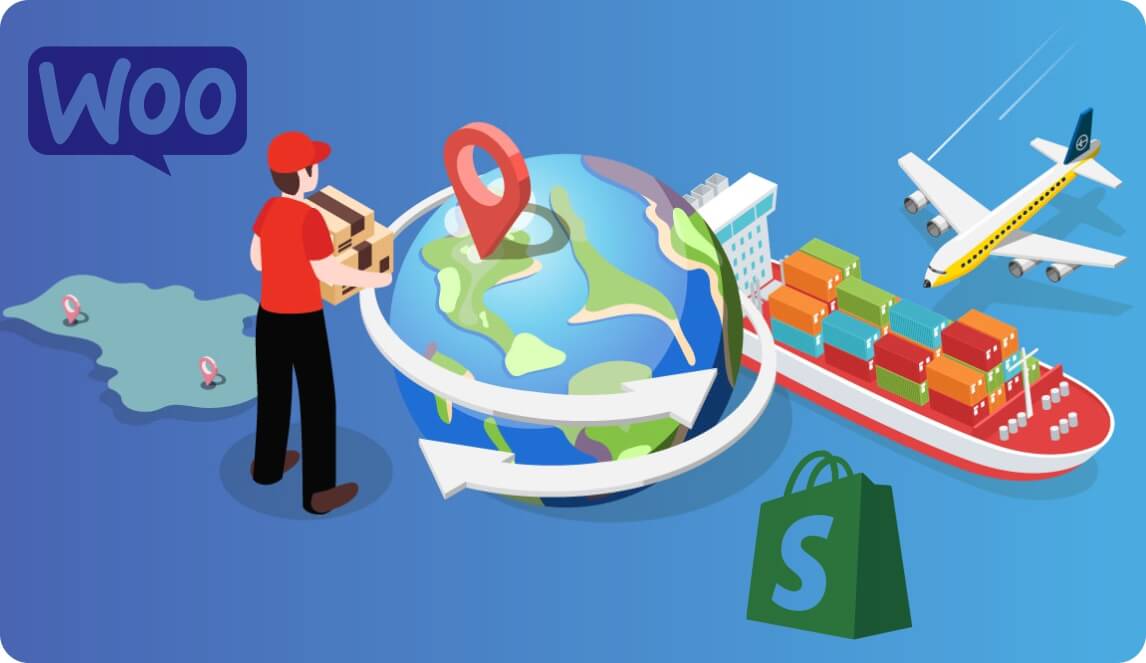Get in touch


Cross-border Shipping : A Beginner’s Guide to Shopify and WooCommerce Integration
July 28, 2025
Chaitanya

Global ecommerce sales are projected to surpass $6 trillion by 2026, and crossborder transactions form a significant chunk of that growth. Hence, expanding your ecommerce business globally is no longer optional; it’s essential.
Several ecommerce platforms, especially Shopify and WooCommerce, make it easier than ever to sell across borders. However, international shipping brings along a set of problems, such as customs clearance, delivery terms, tax compliance, and customer expectations.
This guide walks you through the important protocols and processes of crossborder shipping with Shopify and WooCommerce. Regardless of whether you are just starting out or already own a globally operational business, by the time you are finished reading, you will have a fair idea about how to proceed with integration steps, choose between DDP vs DAP, and handle international taxes. We will also help you understand how Atlantic International Express can support your every step on this journey.
Cross-Border Shipping: Relevance
Driven by rising internet access, ease of shopping, and consumer demand for international products, crossborder ecommerce is reshaping global trade, especially the retail side of it.
By 2025, it’s expected to account for 25% of all e-commerce transactions. While North America and Europe continue to expand steadily, it is the emerging Asian markets that are dominating this industry, with an average growth rate of 27.9%, and this trend is only expected to grow, judging by global buying patterns so far.
Hence, integration with Shopify and WooCommerce has now become a method of survival for ecommerce players of all sizes. And having a trusted logistics partner like Atlantic International Express makes sure your business receives the support and scalability it deserves in international markets. Let us get you going!
Integration Steps: Shopify & WooCommerce
Before your boxes cross the border, you need to integrate your ecommerce platform with logistics tools that support international delivery, customs documentation, and real-time tracking.
-
Shopify Integration
Shopify offers built-in support for international shipping through its Markets feature and third-party apps.
Steps:
-
Enable Shopify Markets to manage currencies, regions, and duties.
-
Install a shipping app like Easyship, ShipStation, or DHL Express.
-
Configure shipping zones and rates based on destination.
-
Connect carrier accounts for label generation and live tracking.
-
Use Shopify’s API for advanced automation. Explore Shopify API Docs
Atlantic Advantage: We integrate seamlessly with Shopify’s shipping ecosystem, offering real-time tracking, customs documentation, and flexible pickup/delivery options.
-
-
WooCommerce Integration
WooCommerce’s open-source flexibility makes it ideal for custom shipping setups.
Steps:
-
Install shipping plugins like WooCommerce Shipping, Table Rate Shipping, or FedEx.
-
Set up shipping zones and methods for each country.
-
Enable tax and duty calculators via plugins like Zonos or Avalara.
-
Integrate with fulfillment services using REST API. Explore WooCommerce API Docs
Atlantic Advantage: Our WooCommerce-compatible solutions simplify international protocols, automate customs paperwork, and ensure timely delivery across borders.
-
DDP vs DAP: What’s Best for YOU?
When shipping internationally, the business and the customer must mutually decide on who pays duties and taxes. This is where Incoterms such as DDP (Delivered Duty Paid) and DAP (Delivered at Place) come into play.
Incoterms are three-letter trade codes published by the International Chamber of Commerce (ICC). They are internationally recognized rules that define the roles of buyers and sellers in global shipping. For more info click here.
-
DDP (Delivered Duty Paid)
You (the business) cover all duties, taxes, and customs fees upfront. The customer receives the package without additional charges.
Pros:
-
Better customer experience and retention
-
Competitive advantage
-
Fewer delivery delays
-
Lower risk of returns
Cons:
-
Higher upfront cost
-
More liability, especially custom checks
-
-
DAP (Delivered at Place)
The customer pays duties and taxes upon delivery. You ship the item, but customs clearance is their responsibility.
Pros:
-
Lower cost for the seller
-
Simpler setup
Cons:
-
Risk of delivery refusal
-
Poor customer experience
Atlantic Insight: We help you assess whether DDP or DAP is best for your objectives and target markets. Our team ensures accurate duty calculations and offers DDP-ready shipping options to reduce friction at delivery. We also offer services like free pickup and packaging along with a variety of deals and discounts. Click here to know more.
-
Handling Taxes & Duties
Taxes and duties are critical to the success of cross-border ecommerce. Mishandling them can result in rejected shipments, costly fines, and unhappy customers. Reputation is the most valuable asset for any ecommerce venture, and losing it can mean losing future business opportunities. That’s why it’s absolutely essential to manage these processes with care and professionalism, leaving no room for mishaps.
Key Tax Considerations:
-
HS Codes: Ensure products are classified correctly. Incorrect codes might lead to complications in shipment or even rejection in some cases.
-
VAT/GST Registration: Some countries require sellers to register locally.
-
Tax Calculation: Make sure you account for all necessary expenses and have an accurate estimate of taxes payable. You can use tools like Alvara.
-
Customs Documentation: Include commercial invoices, packing lists, and certificates of origin.
-
Shopify :Offers built-in tax settings and integrates with Avalara.
-
WooCommerce : Supports plugins that calculate duties based on destination and product type.
Atlantic Support: Due to the complexity of the documentation process, which is also essential for taxation, we offer unparalleled documentation assistance, including customs, HS code classification, and tax compliance at Atlantic International Express. We not only deliver goods but also deliver peace of mind to our customers. Click to know more.
Let us take your e-commerce across the border, the Atlantic way!
Whether you're just starting out or optimizing an existing international operation, let us be your launchpad. The world is buying. Let us help you make sure they buy from you!
Partner with Atlantic International Express and unlock seamless crossborder shipping, documentation support, and reliable logistics solutions tailored to your business.
Let’s get your products moving!
FAQs
We offer end-to-end support—from pickup and packaging to customs paperwork and delivery tracking. Our team is available to guide you through every step. Click here
Just reach out to us or explore our integration guides for Shopify and WooCommerce. We’ll help you set up your shipping zones, taxes, and global e-commerce strategy.
Some countries require local tax registration for e-commerce sellers. Our team helps you understand where registration is necessary and ensures compliance with local tax laws.
You’ll need commercial invoices, packing lists, HS codes, and certificates of origin. Atlantic International Express offers complete documentation support to avoid customs delays. Click here
Atlantic offers effortless integration through plugins and APIs. We also offer real-time tracking, customs documentation, and DDP-ready shipping, making everything hassle-free.
DDP (Delivered Duty Paid) enables a better customer experience because it covers all duties and taxes upfront, reducing liability for customers. DAP (Delivered at Place) makes the customer cover these costs instead. This can lead to refusal or dissatisfaction.


